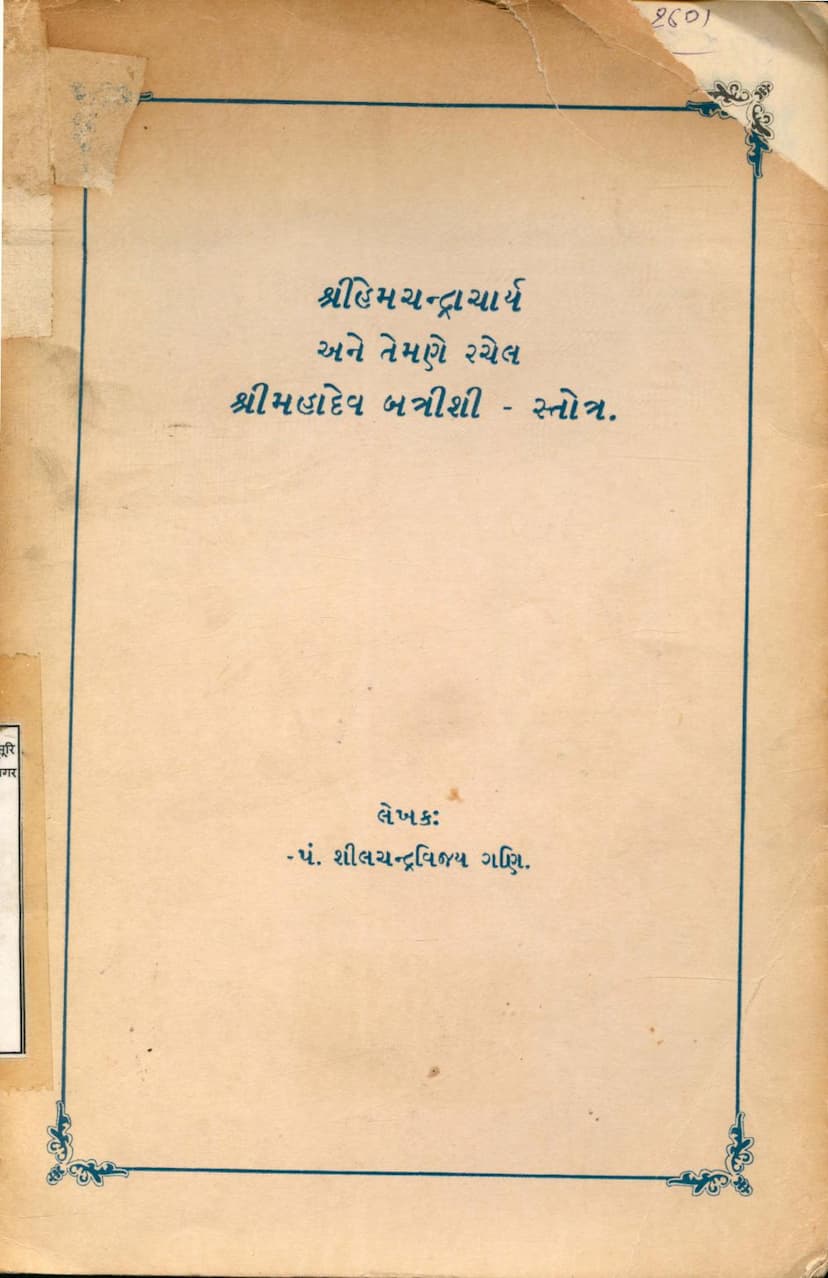Hemchandracharya Ane Temne Rachel Mahadev Battrishi Stotra
Added to library: September 1, 2025

Summary
Here's a comprehensive summary of the provided Jain text, focusing on Hemchandracharya and his "Mahadev Battriśī Stotra":
Book Title: Hemchandracharya Ane Temne Rachel Mahadev Battrishi Stotra (Hemchandracharya and the Mahadev Battriśī Stotra Composed by Him) Author: Pandit Sheelchandravijay Gani Publisher: Shri Jain Granth Prakashan Samiti, Khambhat Year: Vikram Samvat 2045 (during the 900th birth anniversary year of Hemchandracharya)
This document is a scholarly work that delves into the life and literary contributions of Acharya Hemchandracharya, a highly revered figure in Jainism, particularly known for his multifaceted genius and profound impact on Jain philosophy, literature, and the societal fabric of Gujarat. The primary focus is on his composition, the Mahadev Battriśī Stotra.
Key Themes and Information Presented:
-
Hemchandracharya's Significance:
- The book is published during the 900th birth anniversary year of Hemchandracharya, highlighting his enduring legacy.
- His birthday is noted as Kartiki Purnima, a day celebrated by other significant religious figures like Lord Buddha, Guru Nanak Dev, and Shrimad Rajchandra, underscoring the auspiciousness of his birth.
- Hemchandracharya's life is broadly categorized into four key areas: literary creation, character building, promotion of Ahimsa (non-violence), and a life dedicated to Brahmacharya (celibacy), yoga, and asceticism.
-
Literary Prowess:
- Hemchandracharya is lauded for his mastery across various literary genres, comparable to ancient Indian scholars like Panini, Katyayana, Patanjali, Amarasiṁha, Kalidasa, Valmiki, and Vyasa. He is credited with not only composing in these genres but also refining and enriching them with his unique insights.
-
Promoter of Ahimsa and Moral Values:
- A significant portion of the text details Hemchandracharya's efforts in inculcating moral and ethical values, especially Ahimsa, in Gujarat and its surrounding regions.
- His work is credited with infusing Gujarati language and culture with virtues like compassion, generosity, gentleness, civility, modesty, and tolerance. The enduring influence of his teachings is seen in Gujarat's comparative avoidance of vices like gambling and violence.
- His philosophy of Ahimsa was deeply ingrained in his life, stemming from his compassion for all living beings. He emphasized that causing harm to any creature, even unintentionally, is an inexcusable offense against nature.
-
Influence on King Kumarpal:
- Hemchandracharya's association with King Kumarpal of Gujarat is highlighted as a pivotal opportunity to propagate Ahimsa.
- The text discusses the implementation of Kumarpal's decrees on Ahimsa and temperance, noting the nuanced approach taken with vassal kingdoms, where the adherence to these principles might have varied.
- A debate is presented regarding the extent of cow protection (Govaḍhabandhī) during Kumarpal's reign, referencing epigraphic evidence and scholarly interpretations, particularly from Dr. Hasamukh Sankalia. The author refutes the idea that Kumarpal's efforts were limited solely to cow protection, emphasizing his broader commitment to the protection of all life.
-
The "Siddha-Hema Sahdānushāsana" and the Kumarpal Era:
- The text discusses the Vikram Samvat (era) established by Kumarpal, named "Siddha-Hema Kumara Samvat," a testament to his reverence for Hemchandracharya.
- The establishment of this Samvat is debated, with the author suggesting it was likely initiated after Kumarpal solidified his reign and began focusing on welfare activities, rather than at his coronation or death.
- The text also touches upon the dating of Hemchandracharya's work "Abhidhāna Chintāmaṇi," suggesting a later date than some scholarly estimations based on references to the Kumarpal Samvat.
-
The Mahadev Battriśī Stotra:
- The central piece of the work is an examination of the "Mahadev Battriśī Stotra."
- It is clarified that the true name of the stotra is "Mahadev Battriśī" or "Mahadev Dvātriṁśikā," meaning "Thirty-two Verses on Mahadev," rather than simply "Mahadev Stotra."
- The stotra's composition is linked to Hemchandracharya's visit to the Somnath temple with King Kumarpal. Faced with a challenge from a rival pundit, Hemchandracharya, through his profound philosophical insight and spiritual prowess, is said to have composed and recited this stotra, integrating Jain principles with the worship of Shiva.
- The stotra is interpreted as a synthesis of Jain philosophy, equating the attributes of Mahadev (Shiva) with the core principles of Jainism, such as the Pancha Parameshthi (five supreme beings) and the qualities of the Tirthankaras (Jinas).
- The text critically analyzes common beliefs about the stotra, particularly regarding its current length (44 verses) and the assertion that only the last verse was recited at Somnath. The author posits that the original stotra likely had 32 or 33 verses, and subsequent additions have expanded it over time.
- The stotra's verses are examined for their philosophical depth, particularly how they connect universal principles (like Brahma, Vishnu, Mahesh) with Jain concepts of knowledge, conduct, and perception. The author highlights the profound ability of Hemchandracharya to find underlying unity in different philosophical systems.
- A significant point is made about the connection between the "a-ha-ma" mantra (derived from the syllable "Arh" in Jainism) and the triumvirate of Brahma, Vishnu, and Mahesh in Hindu philosophy, as elucidated in Hemchandracharya's commentaries.
-
Hemchandracharya's Disciples:
- The work also briefly mentions the scholarly eminence of Hemchandracharya's disciples, specifically highlighting Acharya Ramachandra, known for his literary works and his unyielding adherence to his guru's teachings, even in the face of death.
-
Scholarly Approach:
- The text provides details about the textual basis for the "Mahadev Battriśī Stotra," referencing palm-leaf manuscripts and printed editions, and noting variations in readings and verse order.
- The author emphasizes the need for critical examination of traditional interpretations and the importance of understanding Hemchandracharya's works in their true context.
In essence, the book presents Hemchandracharya not just as a Jain scholar and monk but as a visionary intellectual and spiritual leader who deeply influenced the cultural and ethical landscape of his time, leaving behind a rich legacy of literature and philosophy, epitomized by works like the "Mahadev Battriśī Stotra" which beautifully bridges different spiritual traditions.